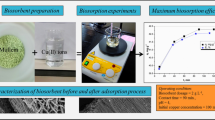Abstract
In this study the ability of Cercis siliquastrum L. leaves for the adsorption of Pb(II), Cu(II) and Ni(II) ions were studied. The effects of different parameters such as contact time of biosorbent and sorbents, pH of metal solution, and initial metal ion concentration on the biosorption were investigated. The maximum sorption of all metals were carried out in pH 4. Increasing the initial metal concentration in lower values caused a steep growth in biosorption, which was not observed in higher values. In the optimum sorption condition, the affinity of the leaves to metal ions was in the order of Pb(II)>Cu(II)>Ni(II). The biosorption of the metal ions were studied by Langmuir and Freundlich adsorption isotherm models. It was observed that the data were fitted very well to Langmuir adsorption isotherm model. According to the obtained correlation coefficient values, Freundlich model could predict Pb(II) and Cu(II) adsorption adequately but it was not suitable for Ni(II) sorption. Experimental data were exploited for kinetic evaluations related to the sorption process. According to our results, second-order kinetic provided a good description of biosorption for the tested metals with regression correlation coefficients more than 0.9998 for all the sorbate-sorbent systems.
Similar content being viewed by others
References
C.W. Cheung, C.F. Porter and G. McKay, Sep. Purif. Technol. 19 (1997) 55.
S.P.K. Sternberg, R.W. Dom, Biores. Technol. 81 (2002) 249.
C. Huang, C.P. Huang, Water Res. 30 (1996) 1985.
J.T. Matheickal, Q. Yu and J. Feltham, Environ. Technol. 18 (1987) 25.
E. Luef, T. Prey and C.P. Kubicek, Appl. Microbiol. Biot. 34 (1991) 688.
M. Nourbakhsh, Y. Sag, D. Ozer, Z. Aksu, T. Katsal and A. Calgar, Process Biochem. 29 (1994) 1.
P. Puranik, K.M. Paknikar, Biores. Technol. 70 (1999) 269.
B. Verma, N.P. Shukla, Indian J. Environ. Health 42 (2000) 145.
R. Say, A. Denizli and M.Y. Arica, Biores. Technol. 76 (2001) 67.
R. Apiratikul, T.F. Marhaba, S. Wattanachira and P. Pavasant, J. Science Technol. 26 (2004) 199.
N.R. Bishnoi, M. Bajaj, N. Sharma and A. Gupta, Biores. Technol. 91 (2004) 305.
P. Lodeiro, B. Cordero, J.L. Barriadh, R. Herrero and M.E.S. deVicente, Biores. Technol. 96 (2005) 1796.
K. Chandrasekhar, C.T. Kamala, N.S. Chary and Y. Anjanuyulu, Int. J. Miner. Process. 68 (2003) 37.
Y.S. Ho, C.T. Huang and H.W. Huang, Proc. Biochem. 37 (2002) 1421.
M. I. Kandah, Chem. Eng. Technol. 25 (2002) 921.
R. Naseem, S.S. Tahir, Water Res. 35 (2001) 3982.
F.F.O. Orumwense, J. Chem. Technol. Biotechnol. 65 (1996) 363.
A. Kapoor, T. Viraraghavan and D. Roy Cullimore, Biores. Technol. 70 (1999) 95.
F.A. Abu Al-Rub, M.H. El-Naas, F. Benyahia and I. Ashour, Proc. Biochem. 39 (2004) 1767.
G. Cetinkaya Donmez, Z. Aksu, A. Ozturk and T. Kutsal, Proc. Biochem. 34 (1999) 885.
D.Y. Cho, S. Lee, S. Park and A. Chung, J. Environ. Sci. Health A 29 (1994) 389.
R. Axtell Nicholas, P.K. Sternberg Steven and K. Claussen, Biores. Technol. 89 (2003) 41.
S.S. Ahluwalia, D. Goyal, Biores. Technol. 98 (2007) 2243.
V. Mozaffarian, Trees and Shrubs. Farhang Moaser Publisher, (2004) Tehran.
J.M. Tobin, D.G. Cooper and R.J. Neufeld, Appl. Environ. Microbiol. 47 (1984) 821.
A. Saeed, M.W. Akhter and M. Iqbal, Sep. Purif. Technol. 45 (2005) 25.
S. Schiewer, B. Volesky, in: Lovely D.R. (Ed.), Environmental Microbe-Metal Interactions, ASM Press, (2000) Washington DC, Chapter 14.
Y.S. Ho, C.T. Huang and H.W. Huang, Proc. Biochem. 37 (2002) 1421.
S. Al-Asheh, F. Banat, R. Al-Omari and Z. Duvunjak, Chemosphere 41 (2000) 659.
W. Jianlong, Z. Zinmin, D. Decai and Z. Ding, J. Biotechnol. 87 (2001) 273.
A. Saeed, M.W. Akhter and M. Iqbal, J. Hazard. Mater. 117 (2005) 65.
A.C.A. da Costa, S.G.F. Leite, Biotechnol. Lett. 13 (1991) 559.
Y.S. Ho, D.A.J. Wase and C.F. Forster, Environ. Technol. 13 (1996) 925.
N. Unlu, M. Ersoz, Sep. Purif. Technol. 52 (2007) 461.
Author information
Authors and Affiliations
Corresponding author
Additional information
This article is dedicated to Professor Habib Firouzabadi who actively participated in training of the new generation of scinetists in Iran on the occasion of his 65th birthday
Rights and permissions
About this article
Cite this article
Salehi, P., Asghari, B. & Mohammadi, F. Removal of heavy metals from aqueous solutions by Cercis siliquastrum L.. JICS 5 (Suppl 1), S80–S86 (2008). https://doi.org/10.1007/BF03246493
Received:
Revised:
Published:
Issue Date:
DOI: https://doi.org/10.1007/BF03246493




